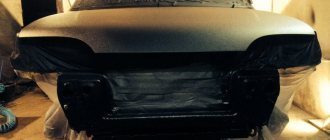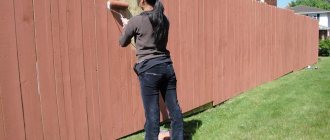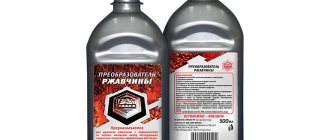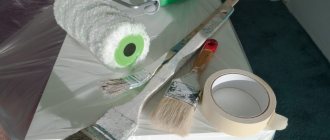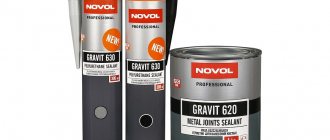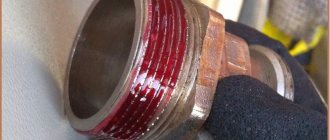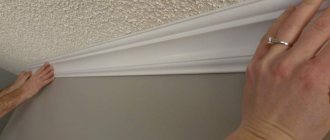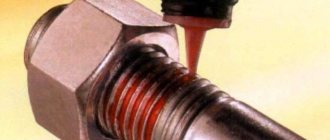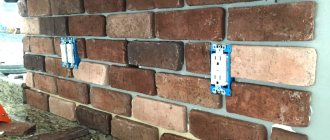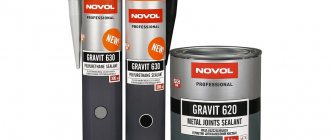Sealant selection criteria
Automotive stores sell a variety of sealants: for hatches, bodies, and pipe connections. They differ in terms of heat resistance, elasticity, and service life. The highest quality, but most expensive, are professional products, which are sold in large containers and are usually used in auto repair shops.
For home use, sealants are purchased in tubes of suitable volume (40-200 g). If you decide to give preference to the latter option, it is better to purchase the material in an aluminum tube: it fully retains its properties throughout its shelf life. Cheaper products are presented in plastic tubes, but when purchasing, be sure to check the remaining shelf life: it should be at least 6 months.
Some sealants have a convenient dispenser tip: they can be easily applied even to surfaces in hard-to-reach areas. Body sealant in a cartridge requires the additional purchase of a glue gun, without which you will not be able to use the product.
The best heat-resistant sealants for cars
Permatex Ultra Copper
The sealant is completely safe for catalysts and oxygen sensors. Of course, cleaning it during subsequent repairs will be problematic, but there’s no getting around it - a good sealant should hold tight. It retains its elasticity and strength during repeated heating cycles and withstands temperature changes well.
- Efficiency
- Durability
- Do not use in large gaps - over time, the tightness may break down
Done Deal DD6731
This sealant is of good quality and is identical in maximum operating temperature to Permatex. You can use it with confidence, but for what we will definitely reduce the rating points for the manufacturer is for an absolutely conditional site, where there is not only TDS/SDS information sheets (technical and safety data), but also a catalog. This is especially amusing in combination with the inscription “meets OEM standards” on the packaging. True, it seems to be a big secret which manufacturers’ standards it meets.
Types of seam sealants
Any joint sealant for cars has a reliable composition, otherwise it will not be able to provide the proper level of sealing of the joints. And yet the materials are not the same in their basis, therefore they differ in properties and characteristics.
Acrylic based mixtures
Acrylic sealants are prepared on the basis of polymer compositions. They have good adhesion to the surface, but under strong vibration or shock loads they can peel off due to their average elasticity. It is best to use such products for porous materials and stable joints and seams. Any sealants with acrylic can be painted or varnished.
Anaerobic sealants
Such products are easy to distinguish from others: they have a liquid texture, which is why they are called “liquid pads”. The sealant is distributed inside cavities and the smallest cracks, and hardens only after contact with oxygen ceases. Typically, anaerobic compounds are used to repair small areas, otherwise there is a risk of insufficiently strong seams. Most often, the compositions are used by professionals, because they must be applied correctly and strictly follow the instructions.
Silicone sealants
They are considered the best option for home repairs of metal products. Such sealants are easy to apply, harden quickly, and retain strength and elasticity for a long time. Silicone is impermeable to moisture even at high pressure and is not afraid of temperature changes. With significant air humidity, it hardens very quickly - in 10-15 minutes. Typically, products are applied from a tube with a long nozzle. They can fill irregularities up to 6 mm deep.
Polyurethane compounds
These sealants are the most popular on the market and are available in a huge range. They can be sprayed or paste-like for brush application. Distinctive features of polyurethane sealants are:
- ease of use;
- no spreading from vertical bases;
- high flexibility, elasticity, heat resistance, moisture resistance;
- withstand large mechanical loads.
Bitumen mixtures
Presented in the form of compositions based on bitumen with the addition of modifiers, fillers, and adhesion accelerators. They look like a dark paste. They do not require careful surface preparation and are suitable for most materials, including any metals. Can be used in damp environments and tolerate direct contact with water.
How long does it take for glass sealant to dry in summer and winter?
To more accurately determine how long it takes for a glued windshield to dry, you need to take into account the time of year. In general, the replacement technology in winter and summer is the same, however, in winter the procedure can only be performed indoors, while in summer replacement outdoors is permissible.
If we take into account the difference in air humidity, then in summer the sealant hardens on average in 1.5 hours, and in winter - in 2.5–3 hours. During this time, it is prohibited to open the doors, windows of the car or move it. Any movement can cause the glass to vibrate, causing the seal to be broken.
How to check glass
Before picking up the car from the workshop, you can check the quality of the work performed yourself. And if you replaced the double-glazed window yourself, first check in the instructions how long the windshield should dry after gluing it with the selected glue. If you start checking before drying, you can ruin the work.
To test the glass for strength, press it from the inside and listen: there should be no cracking.
Regardless of how long the windshield adhesive takes to dry, it is recommended to check for tightness only after three days, when the adhesive has already crystallized. To ensure accurate results, it is best to wash your car at a professional car wash using high-pressure washers. After washing, carefully check the seam for leaks. If there are any, and the replacement was carried out in a workshop, the work will be corrected under warranty.
Rules for operating a car after replacing the windshield
Despite the fact that 1.5–3 hours after replacing the double-glazed window you can drive a car, it is not recommended to immediately return to your usual driving style. The first few days you should be extra careful. To do this, follow simple rules during the first three days:
- ♦ If possible, avoid potholes on the road and do not run over curbs.
- ♦ Do not park on uneven surfaces - the car should not be parked on an incline for long, as the sealant has not yet fully set.
- ♦ Avoid exposure to rain and snow for the first day, and it is better to wash your car only after three days. In some cases, washing the next day is allowed, but it is better to check this with the workshop where the replacement was carried out.
- ♦ Don't slam doors too much.
- ♦ Do not abuse the stove and air conditioner.
- ♦ Do not accelerate over 70 km/h.
If you are not careful, the seal of the adhesive may be compromised. In addition, experts recommend replacing the wipers, since sand particles usually remain on the old ones, which can scratch the new double-glazed window and significantly reduce its service life.
Types of body sealants by application method
You can determine exactly how the sealant is applied by its texture and type of packaging. Also, the application method is always indicated in the instructions for use of the composition.
Sprayable moisture-curing sealant
Typically, such products are based on modern polymers. The compositions are one-component, contain a large amount of dry substances, therefore they quickly harden in air under the influence of humidity and form a very durable seam. Sprayable sealants are applied with a special spray gun. It is especially convenient to work with them in the area of the underbody, engine compartment, and trunk of a car.
Brush sealant
Such compositions are made on the basis of silicone and nitro rubber; they are sold in cans of 1 kg or larger. Sealants can be used to seal joining and weld seams, glue jumpers, flavors, pallets, seal the trunk, wheel arches. Usually the products are available in white, gray, black colors. They are applied with a brush, dry in literally 10 minutes and can be painted immediately.
Sealant tape
Applying sealant to a car often requires a lot of skill, otherwise the seam will not be perfectly smooth. If you don’t have confidence in your own skills, use tape, which is very easy to use. Tape sealant does not need to be lubricated with glue - it already has an adhesive base. Flexibility allows the material to be used in any location during body repairs. Immediately after gluing, the tape can be painted - it does not require drying.
Extruded sealants
Such compositions are sold in tubes and cartridges. To seal joints, seams, the material must be squeezed onto the parts to be joined manually or using a gun. The seam will be most uniform when using an air gun. Typically, such products are used to seal the seams of the hood, the inside of the doors, the engine compartment, and the trunk.
Instructions for use
How to use ABRO sealants:
- Prepare the surface. Clean it from traces of the previous sealant (gasket), dirt, and degrease.
- Put on a special nozzle and cut off its tip. For 310 ml sealants you will need a special gun.
- Apply sealant to the desired surface.
- If this is a gasket sealant or requires gluing with another part, then you need to wait 10 minutes before connecting.
Before proceeding with further work, you must wait until the sealant hardens. Therefore, you need to know how long this product takes to dry. Complete curing of the sealant occurs after 24 hours.
During installation, excess product can be removed with a cloth moistened with alcohol or simply with a dry soft cloth. When the silicone hardens, you can remove it with a knife or scraper.
Popular Products
To choose a good automotive seam sealant, you should pay attention to the most famous and high-quality products on the market.
Merbenit XS55
It is a high-strength sealant for the hood, underbody and other parts of the body on a modified silicon base. It has enormous tensile strength (4 N/sq. mm), excellent adhesion to metal and plastic. In addition to sealing seams, it can be used when installing climate control equipment and ventilation. In factory conditions it is used in the automotive industry, carriage building, and in the production of polymers. The advantages of the sealant are undoubted:
- ideal filling of even the smallest cracks;
- possibility of painting the finished seam;
- absence of harmful solvents and unpleasant odors;
- resistance to water, salt, oils, alkali solutions and acids;
- tolerance to vibration, shock, atmospheric influences.
BODY 999
Body 999 sealant can be found at any automotive store. It is considered one of the most common and is sold in 150 ml tubes, 300 ml cartridges, and 1000 ml cans. A polyurethane-based product is used to fill voids and treat machine welds to protect against water and the harmful effects of atmospheric factors. The sealant is great for metal, plastic, and painted surfaces, but it should not be applied to areas exposed to ultraviolet radiation.
The advantages of the material are:
- maintains elasticity for a long time;
- does not shrink;
- does not flow on vertical surfaces;
- can be applied even in a thick layer and not crack;
- has a high degree of adhesion to surfaces;
- ready to use, does not require dilution;
- Can be painted after drying.
3M 08537
3M automotive seam sealant is also made on the basis of polyurethane. This is a one-component composition, available in black and white, considered universal and suitable for:
- panel connections;
- sealing weld seams;
- processing of arches, thresholds, doors;
- seals of the bottom, joints inside the trunk;
- shock absorber mountings;
- strengthening bolted connections.
The product has a brush application method, is liquid and is available in metal cans. It is resistant to oils and petrochemicals, highly elastic, not afraid of water, does not shrink, maintaining its structure for several years, and dries quickly. After final polymerization, the seam will be hard, but quite elastic. 50 minutes after application it can already be painted with any paint.
Terostat 9320
Teroson line sealant Terostat 9320 is considered a universal “4 in 1” product. This is a sprayable one-component composition based on modern modified polymers, which hardens under the influence of moisture from the air. It comes in black, gray and ocher colors.
After polymerization, the Terostat adhesive-sealant forms an elastic, abrasion-resistant seam, which in appearance will not differ from the factory one. The material has a high degree of adhesion to metals, is compatible with any paints, primers and primers, is resistant to UV radiation, shrinkage, sagging, aging, and hardens quickly in air.
Novol Gravit 630
Novol Gravit 630 sealant is a one-component polyurethane product used for sealing welded joints and soldered areas. It creates an elastic and very durable shell that does not shrink, crack, or wrinkle over time. Novol sealant has good adhesion to metal, as well as to varnished sheet metal. The finished seam can be coated with acrylic paints. The product is applied with a special gun. Its only drawback is its low resistance to ultraviolet radiation.
Reoflex Brush Sealant
Reoflex brand brush sealant is designed for sealing any seams on metal, concrete, wood, and is widely used in body repair. It has high anti-corrosion and sound-proofing properties, is easy to apply and dries quickly. After polymerization, the sealant forms an elastic seam, externally close to the factory one.
Bool
Bool brand polyurethane adhesive-sealant is available in cartridges for a 310 ml gun. It is widely used to strengthen seams between sunroofs, headlight holders, metal parts, and gutters. The finished seam can be painted with all types of varnishes. The product is sold in white, beige, black colors.
APP PU50
This material is one-component, made on the basis of polyurethane. APP has a high degree of adhesion to primed and painted metal, stainless steel, glass, all types of plastic, concrete and aluminum. In body repair it is used to seal welded joints. The method of application of the material is special: you must first put it on the seam in the form of a roller, then spread it with a spatula or brush.
The best sealants for the exhaust system
Liqui Moly Auspuff-Montage-Paste
The sealant is also functional at the junction of warped flanges, it withstands vibrations and multiple heating/cooling cycles without being painted. So this is a completely workable option for repairs, and it is widely available and affordable.
- Good adhesion to stripped metal
- Vibration resistance
- Very sensitive to the quality of surface preparation (as are all sealants of this type)
How to use sealant correctly
The application of auto sealants has its own nuances, and to obtain a high-quality result, the following rules must be strictly followed:
- Before work, thoroughly clean the surface, remove rust, degrease;
- To enhance adhesion, clean the base with red Scotch-Brite;
- carry out priming with special primers for metal, if this measure is indicated in the instructions for the sealant.
To seal the seams, you need to prepare the composition: if necessary, dilute or print the tube, insert the cartridge into the gun, open the package with tape. You may also need a spatula or brush for the job. Afterwards, you need to apply the composition to the area of the future seam, acting at the same speed along its entire length - this will help make the joint smooth, like a factory one.
Excess sealant should be removed immediately with a spatula or your fingers. If the composition is very sticky, you can sprinkle it with a little water. In the future, it is allowed to paint the seam, but only after the time specified by the manufacturer has elapsed. This usually becomes possible after the sealant has completely polymerized.
Precautionary measures
When working with automotive sealants, the following precautions must be observed:
- Since some sealants can release acetic acid when drying, therefore, when working, use PPE - gloves, goggles, a mask. If the product gets on an open area of skin or on the mucous membrane of the eye, rinse immediately with running water. If irritation occurs, it is better to consult a doctor.
- The process is carried out in a well-ventilated area.
- After using the product, close the tube tightly and place it out of the reach of children.
How to properly remove sealant
If the composition is applied incorrectly or if there is old sealant, the seam must be removed and the work done again. To clean hidden seams, use a mechanical method - remove a layer of material with a sharp spatula, knife, pumice stone, or sandpaper. To make sure you don’t scratch the base, you can use a chemical method - moisten the sealant with white spirit, and then use a knife to separate the softened compound. After preparing the base, you can apply a new layer of sealant, following the manufacturer's instructions.
